Research Report: University Students' Perception of Edible Insects
VerifiedAdded on 2023/01/13
|72
|10961
|84
Report
AI Summary
This research report, focusing on a study conducted by a student, investigates university students' perspectives on entomophagy, the practice of eating insects. The study explores the students' views on the consumption of edible insects, examining their willingness to try insects as food, and their concerns regarding food safety. The research also delves into the students' knowledge of the nutritional value of insects, comparing them to conventional food sources. The methodology includes frequency tables and statistical analyses like Chi-square tests to analyze demographic information and opinions. The findings reveal insights into the students' acceptance of entomophagy, their concerns, and their understanding of the nutritional benefits, providing valuable insights into the younger generation's current perspective on entomophagy and its implications for future culinary trends. The report concludes with implications, recommendations, and limitations of the study, as well as suggestions for future research.
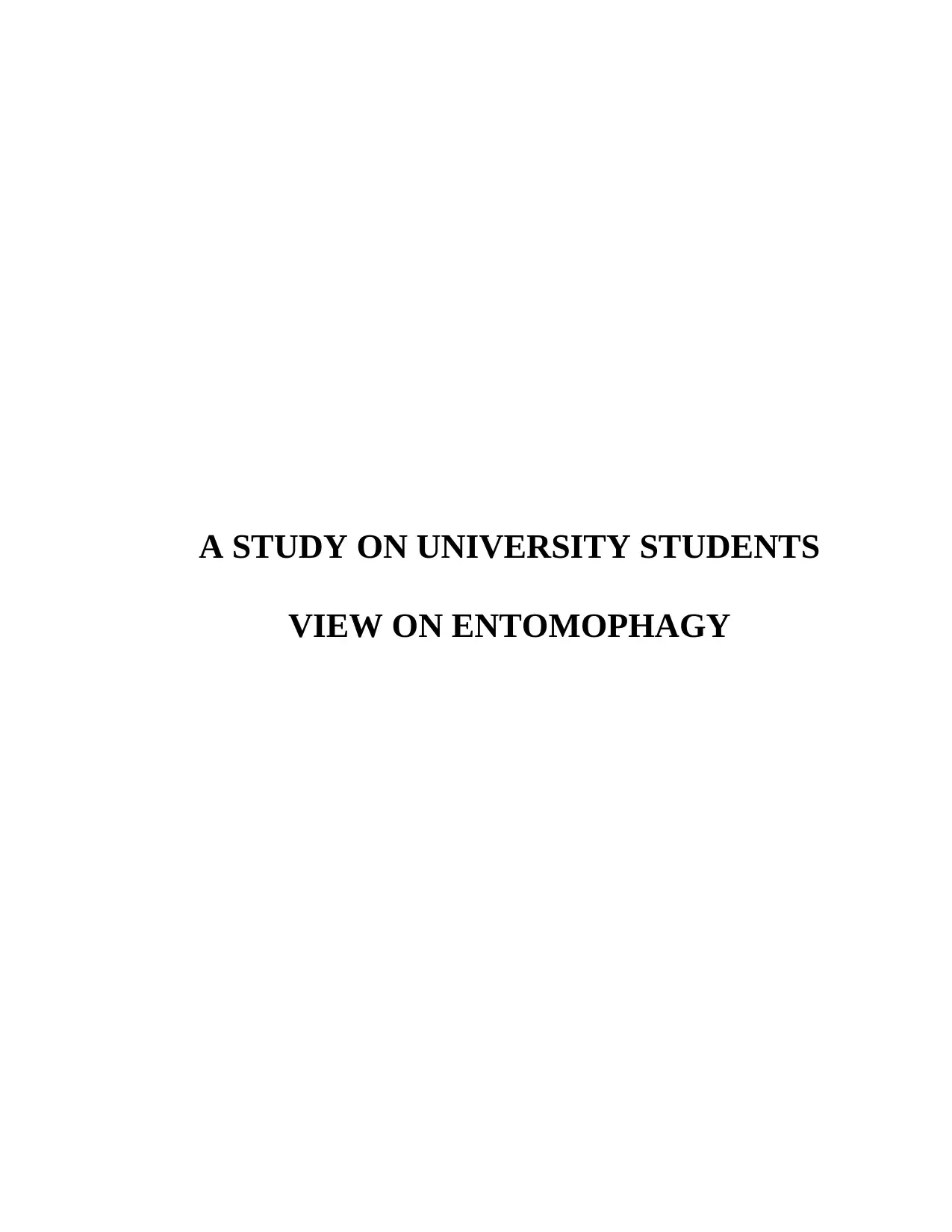
A STUDY ON UNIVERSITY STUDENTS
VIEW ON ENTOMOPHAGY
VIEW ON ENTOMOPHAGY
Paraphrase This Document
Need a fresh take? Get an instant paraphrase of this document with our AI Paraphraser
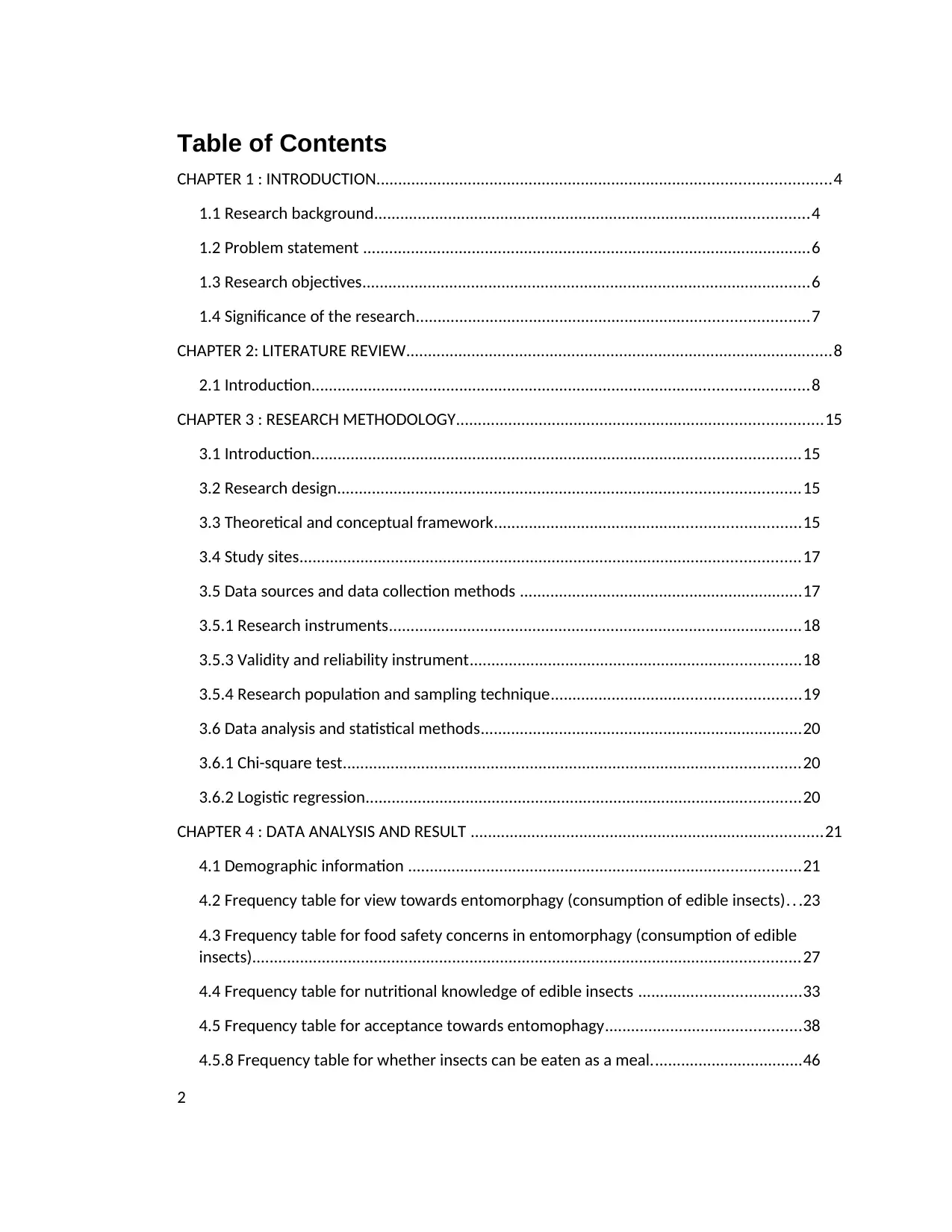
Table of Contents
CHAPTER 1 : INTRODUCTION........................................................................................................4
1.1 Research background....................................................................................................4
1.2 Problem statement .......................................................................................................6
1.3 Research objectives.......................................................................................................6
1.4 Significance of the research..........................................................................................7
CHAPTER 2: LITERATURE REVIEW..................................................................................................8
2.1 Introduction..................................................................................................................8
CHAPTER 3 : RESEARCH METHODOLOGY....................................................................................15
3.1 Introduction................................................................................................................15
3.2 Research design..........................................................................................................15
3.3 Theoretical and conceptual framework......................................................................15
3.4 Study sites...................................................................................................................17
3.5 Data sources and data collection methods .................................................................17
3.5.1 Research instruments...............................................................................................18
3.5.3 Validity and reliability instrument............................................................................18
3.5.4 Research population and sampling technique.........................................................19
3.6 Data analysis and statistical methods..........................................................................20
3.6.1 Chi-square test.........................................................................................................20
3.6.2 Logistic regression....................................................................................................20
CHAPTER 4 : DATA ANALYSIS AND RESULT .................................................................................21
4.1 Demographic information ..........................................................................................21
4.2 Frequency table for view towards entomorphagy (consumption of edible insects). . .23
4.3 Frequency table for food safety concerns in entomorphagy (consumption of edible
insects)..............................................................................................................................27
4.4 Frequency table for nutritional knowledge of edible insects .....................................33
4.5 Frequency table for acceptance towards entomophagy.............................................38
4.5.8 Frequency table for whether insects can be eaten as a meal...................................46
2
CHAPTER 1 : INTRODUCTION........................................................................................................4
1.1 Research background....................................................................................................4
1.2 Problem statement .......................................................................................................6
1.3 Research objectives.......................................................................................................6
1.4 Significance of the research..........................................................................................7
CHAPTER 2: LITERATURE REVIEW..................................................................................................8
2.1 Introduction..................................................................................................................8
CHAPTER 3 : RESEARCH METHODOLOGY....................................................................................15
3.1 Introduction................................................................................................................15
3.2 Research design..........................................................................................................15
3.3 Theoretical and conceptual framework......................................................................15
3.4 Study sites...................................................................................................................17
3.5 Data sources and data collection methods .................................................................17
3.5.1 Research instruments...............................................................................................18
3.5.3 Validity and reliability instrument............................................................................18
3.5.4 Research population and sampling technique.........................................................19
3.6 Data analysis and statistical methods..........................................................................20
3.6.1 Chi-square test.........................................................................................................20
3.6.2 Logistic regression....................................................................................................20
CHAPTER 4 : DATA ANALYSIS AND RESULT .................................................................................21
4.1 Demographic information ..........................................................................................21
4.2 Frequency table for view towards entomorphagy (consumption of edible insects). . .23
4.3 Frequency table for food safety concerns in entomorphagy (consumption of edible
insects)..............................................................................................................................27
4.4 Frequency table for nutritional knowledge of edible insects .....................................33
4.5 Frequency table for acceptance towards entomophagy.............................................38
4.5.8 Frequency table for whether insects can be eaten as a meal...................................46
2
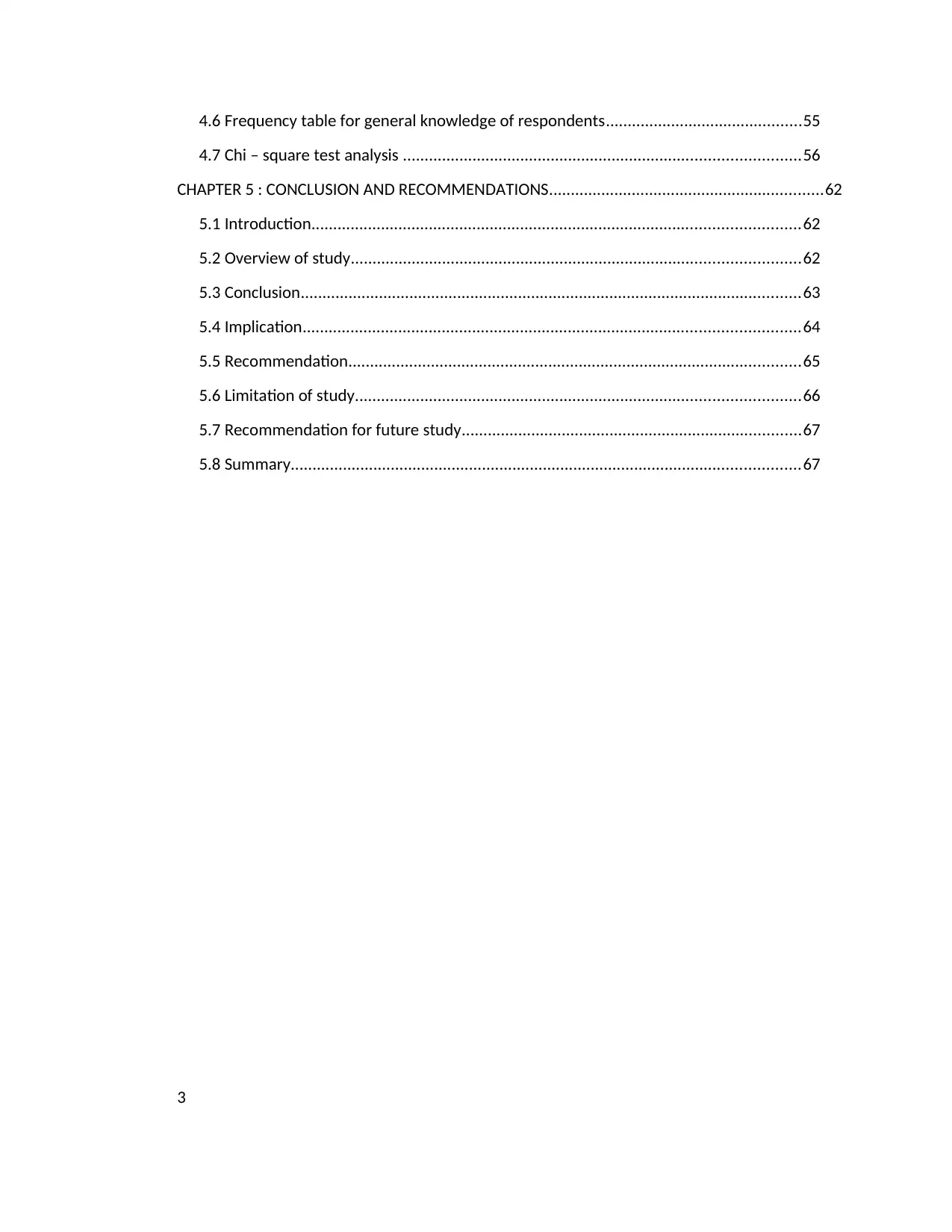
4.6 Frequency table for general knowledge of respondents.............................................55
4.7 Chi – square test analysis ...........................................................................................56
CHAPTER 5 : CONCLUSION AND RECOMMENDATIONS...............................................................62
5.1 Introduction................................................................................................................62
5.2 Overview of study.......................................................................................................62
5.3 Conclusion...................................................................................................................63
5.4 Implication..................................................................................................................64
5.5 Recommendation........................................................................................................65
5.6 Limitation of study......................................................................................................66
5.7 Recommendation for future study..............................................................................67
5.8 Summary.....................................................................................................................67
3
4.7 Chi – square test analysis ...........................................................................................56
CHAPTER 5 : CONCLUSION AND RECOMMENDATIONS...............................................................62
5.1 Introduction................................................................................................................62
5.2 Overview of study.......................................................................................................62
5.3 Conclusion...................................................................................................................63
5.4 Implication..................................................................................................................64
5.5 Recommendation........................................................................................................65
5.6 Limitation of study......................................................................................................66
5.7 Recommendation for future study..............................................................................67
5.8 Summary.....................................................................................................................67
3
⊘ This is a preview!⊘
Do you want full access?
Subscribe today to unlock all pages.

Trusted by 1+ million students worldwide
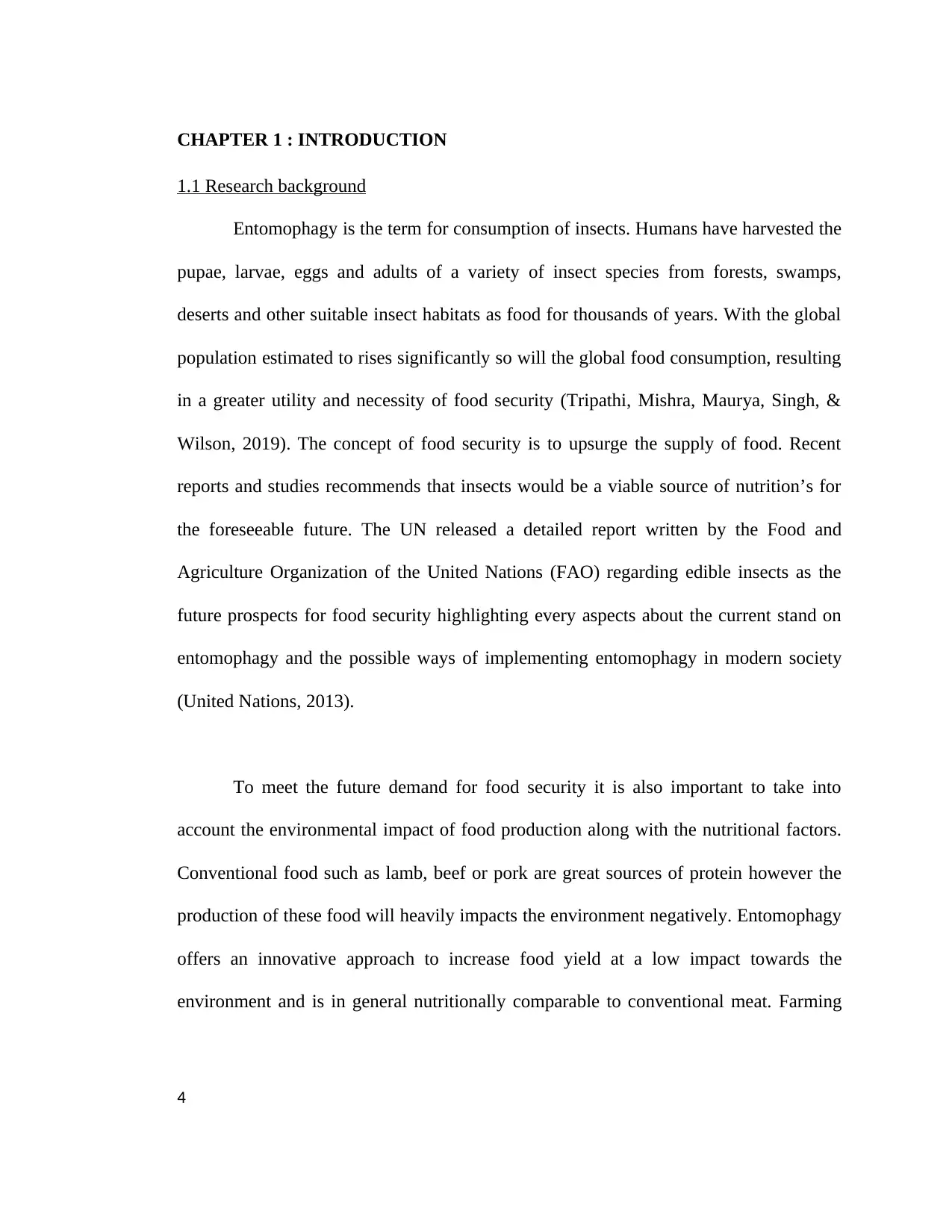
CHAPTER 1 : INTRODUCTION
1.1 Research background
Entomophagy is the term for consumption of insects. Humans have harvested the
pupae, larvae, eggs and adults of a variety of insect species from forests, swamps,
deserts and other suitable insect habitats as food for thousands of years. With the global
population estimated to rises significantly so will the global food consumption, resulting
in a greater utility and necessity of food security (Tripathi, Mishra, Maurya, Singh, &
Wilson, 2019). The concept of food security is to upsurge the supply of food. Recent
reports and studies recommends that insects would be a viable source of nutrition’s for
the foreseeable future. The UN released a detailed report written by the Food and
Agriculture Organization of the United Nations (FAO) regarding edible insects as the
future prospects for food security highlighting every aspects about the current stand on
entomophagy and the possible ways of implementing entomophagy in modern society
(United Nations, 2013).
To meet the future demand for food security it is also important to take into
account the environmental impact of food production along with the nutritional factors.
Conventional food such as lamb, beef or pork are great sources of protein however the
production of these food will heavily impacts the environment negatively. Entomophagy
offers an innovative approach to increase food yield at a low impact towards the
environment and is in general nutritionally comparable to conventional meat. Farming
4
1.1 Research background
Entomophagy is the term for consumption of insects. Humans have harvested the
pupae, larvae, eggs and adults of a variety of insect species from forests, swamps,
deserts and other suitable insect habitats as food for thousands of years. With the global
population estimated to rises significantly so will the global food consumption, resulting
in a greater utility and necessity of food security (Tripathi, Mishra, Maurya, Singh, &
Wilson, 2019). The concept of food security is to upsurge the supply of food. Recent
reports and studies recommends that insects would be a viable source of nutrition’s for
the foreseeable future. The UN released a detailed report written by the Food and
Agriculture Organization of the United Nations (FAO) regarding edible insects as the
future prospects for food security highlighting every aspects about the current stand on
entomophagy and the possible ways of implementing entomophagy in modern society
(United Nations, 2013).
To meet the future demand for food security it is also important to take into
account the environmental impact of food production along with the nutritional factors.
Conventional food such as lamb, beef or pork are great sources of protein however the
production of these food will heavily impacts the environment negatively. Entomophagy
offers an innovative approach to increase food yield at a low impact towards the
environment and is in general nutritionally comparable to conventional meat. Farming
4
Paraphrase This Document
Need a fresh take? Get an instant paraphrase of this document with our AI Paraphraser
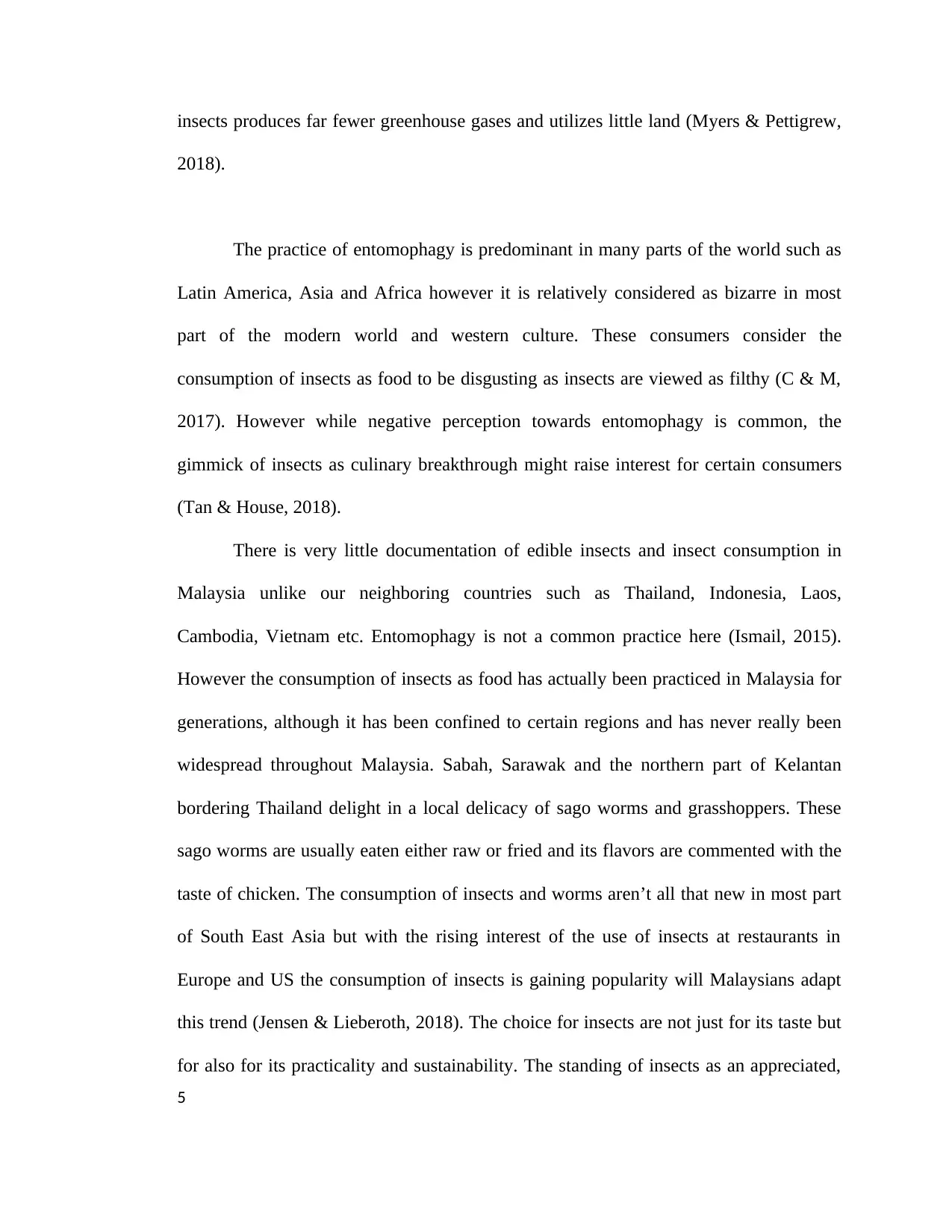
insects produces far fewer greenhouse gases and utilizes little land (Myers & Pettigrew,
2018).
The practice of entomophagy is predominant in many parts of the world such as
Latin America, Asia and Africa however it is relatively considered as bizarre in most
part of the modern world and western culture. These consumers consider the
consumption of insects as food to be disgusting as insects are viewed as filthy (C & M,
2017). However while negative perception towards entomophagy is common, the
gimmick of insects as culinary breakthrough might raise interest for certain consumers
(Tan & House, 2018).
There is very little documentation of edible insects and insect consumption in
Malaysia unlike our neighboring countries such as Thailand, Indonesia, Laos,
Cambodia, Vietnam etc. Entomophagy is not a common practice here (Ismail, 2015).
However the consumption of insects as food has actually been practiced in Malaysia for
generations, although it has been confined to certain regions and has never really been
widespread throughout Malaysia. Sabah, Sarawak and the northern part of Kelantan
bordering Thailand delight in a local delicacy of sago worms and grasshoppers. These
sago worms are usually eaten either raw or fried and its flavors are commented with the
taste of chicken. The consumption of insects and worms aren’t all that new in most part
of South East Asia but with the rising interest of the use of insects at restaurants in
Europe and US the consumption of insects is gaining popularity will Malaysians adapt
this trend (Jensen & Lieberoth, 2018). The choice for insects are not just for its taste but
for also for its practicality and sustainability. The standing of insects as an appreciated,
5
2018).
The practice of entomophagy is predominant in many parts of the world such as
Latin America, Asia and Africa however it is relatively considered as bizarre in most
part of the modern world and western culture. These consumers consider the
consumption of insects as food to be disgusting as insects are viewed as filthy (C & M,
2017). However while negative perception towards entomophagy is common, the
gimmick of insects as culinary breakthrough might raise interest for certain consumers
(Tan & House, 2018).
There is very little documentation of edible insects and insect consumption in
Malaysia unlike our neighboring countries such as Thailand, Indonesia, Laos,
Cambodia, Vietnam etc. Entomophagy is not a common practice here (Ismail, 2015).
However the consumption of insects as food has actually been practiced in Malaysia for
generations, although it has been confined to certain regions and has never really been
widespread throughout Malaysia. Sabah, Sarawak and the northern part of Kelantan
bordering Thailand delight in a local delicacy of sago worms and grasshoppers. These
sago worms are usually eaten either raw or fried and its flavors are commented with the
taste of chicken. The consumption of insects and worms aren’t all that new in most part
of South East Asia but with the rising interest of the use of insects at restaurants in
Europe and US the consumption of insects is gaining popularity will Malaysians adapt
this trend (Jensen & Lieberoth, 2018). The choice for insects are not just for its taste but
for also for its practicality and sustainability. The standing of insects as an appreciated,
5

habitually consumed food can be the result culinary knowledge, wider cultural
acceptance, established routines of food provisioning and the availability, price, form
and taste of products (Menozzi, Sogari, Veneziani, Simoni, & Mora, 2017).
1.2 Problem statement
Consumption of edible insects is viewed as a disgusting food source despite the
claims of its nutritional worth and sustainability perk however a lot of restaurants and
food manufacturers are embracing insects as food to explore new flavors and in hopes to
change the perception of edible insects. It is predicted that insects would be the food of
the future as a source for protein and Malaysians may have to adapt to it at one point.
(UnitedNations, 2013)
As it stands there is little documentation about Malaysian cognizance towards
entomophagy (Ismail, 2015). Since the FAO report, several countries such as
Netherlands, Belgium and Turkey ran research and survey on people’s opinion on
entomophagy. There has been no similar research in Malaysia.
1.3 Research objectives
This study focuses on gathering Malaysians conception on the consumption,
production and concerns of edible insects. The specific objectives of this research are to
identify;
To determine university student’s views on entomophagy.
To investigate food safety concerns regarding edible insects.
To investigate insects as a nutritional food source.
Research questions
This study will attempt to answer the following research questions;
6
acceptance, established routines of food provisioning and the availability, price, form
and taste of products (Menozzi, Sogari, Veneziani, Simoni, & Mora, 2017).
1.2 Problem statement
Consumption of edible insects is viewed as a disgusting food source despite the
claims of its nutritional worth and sustainability perk however a lot of restaurants and
food manufacturers are embracing insects as food to explore new flavors and in hopes to
change the perception of edible insects. It is predicted that insects would be the food of
the future as a source for protein and Malaysians may have to adapt to it at one point.
(UnitedNations, 2013)
As it stands there is little documentation about Malaysian cognizance towards
entomophagy (Ismail, 2015). Since the FAO report, several countries such as
Netherlands, Belgium and Turkey ran research and survey on people’s opinion on
entomophagy. There has been no similar research in Malaysia.
1.3 Research objectives
This study focuses on gathering Malaysians conception on the consumption,
production and concerns of edible insects. The specific objectives of this research are to
identify;
To determine university student’s views on entomophagy.
To investigate food safety concerns regarding edible insects.
To investigate insects as a nutritional food source.
Research questions
This study will attempt to answer the following research questions;
6
⊘ This is a preview!⊘
Do you want full access?
Subscribe today to unlock all pages.

Trusted by 1+ million students worldwide
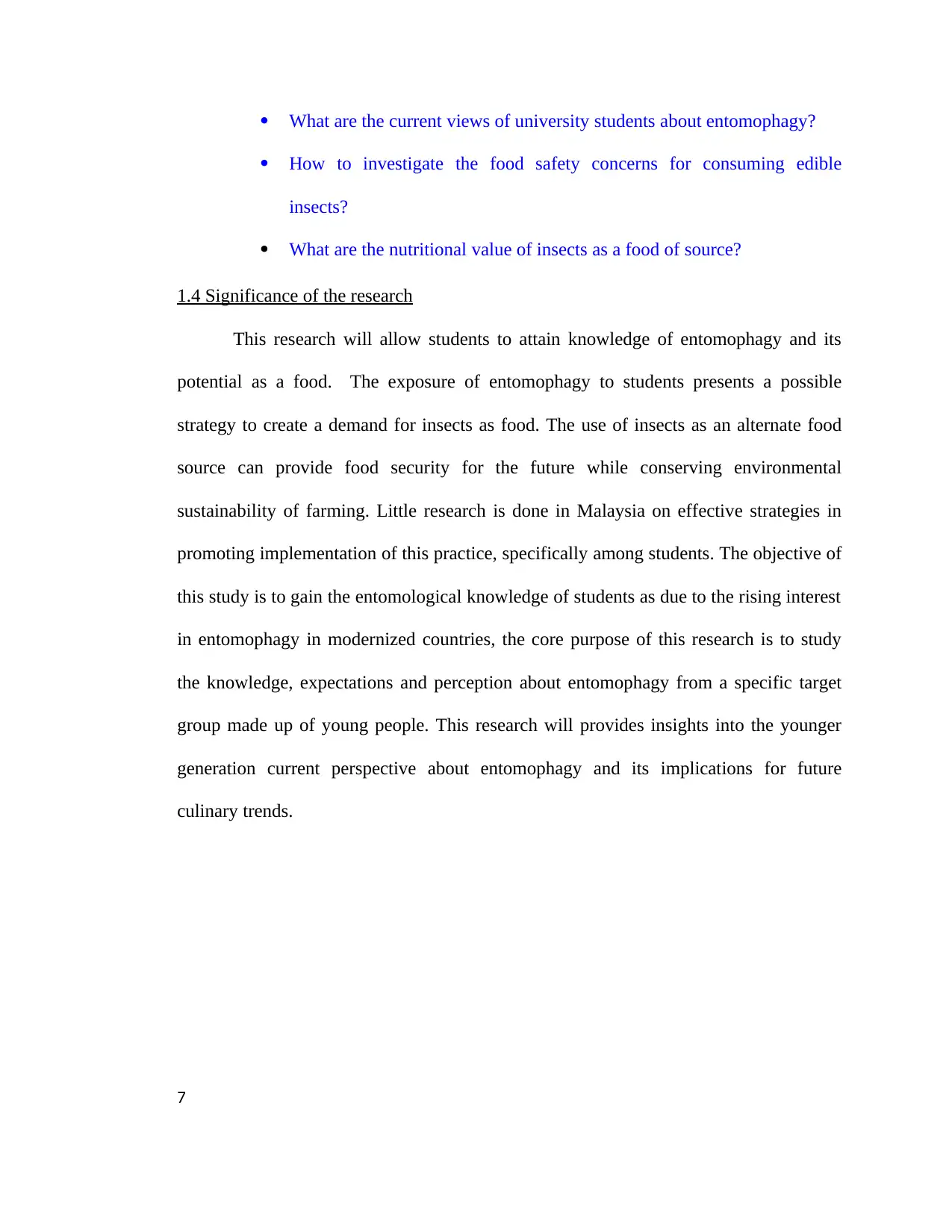
What are the current views of university students about entomophagy?
How to investigate the food safety concerns for consuming edible
insects?
What are the nutritional value of insects as a food of source?
1.4 Significance of the research
This research will allow students to attain knowledge of entomophagy and its
potential as a food. The exposure of entomophagy to students presents a possible
strategy to create a demand for insects as food. The use of insects as an alternate food
source can provide food security for the future while conserving environmental
sustainability of farming. Little research is done in Malaysia on effective strategies in
promoting implementation of this practice, specifically among students. The objective of
this study is to gain the entomological knowledge of students as due to the rising interest
in entomophagy in modernized countries, the core purpose of this research is to study
the knowledge, expectations and perception about entomophagy from a specific target
group made up of young people. This research will provides insights into the younger
generation current perspective about entomophagy and its implications for future
culinary trends.
7
How to investigate the food safety concerns for consuming edible
insects?
What are the nutritional value of insects as a food of source?
1.4 Significance of the research
This research will allow students to attain knowledge of entomophagy and its
potential as a food. The exposure of entomophagy to students presents a possible
strategy to create a demand for insects as food. The use of insects as an alternate food
source can provide food security for the future while conserving environmental
sustainability of farming. Little research is done in Malaysia on effective strategies in
promoting implementation of this practice, specifically among students. The objective of
this study is to gain the entomological knowledge of students as due to the rising interest
in entomophagy in modernized countries, the core purpose of this research is to study
the knowledge, expectations and perception about entomophagy from a specific target
group made up of young people. This research will provides insights into the younger
generation current perspective about entomophagy and its implications for future
culinary trends.
7
Paraphrase This Document
Need a fresh take? Get an instant paraphrase of this document with our AI Paraphraser
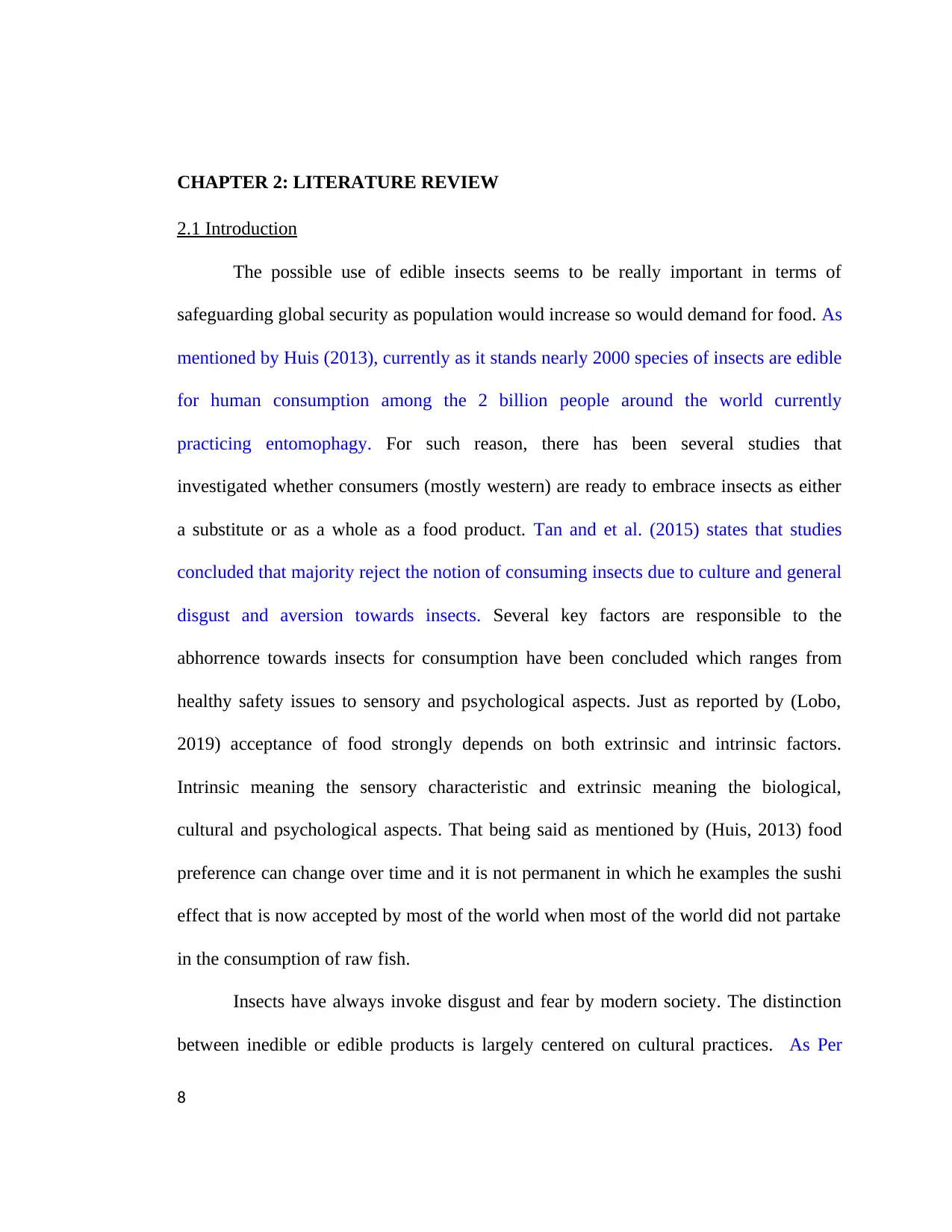
CHAPTER 2: LITERATURE REVIEW
2.1 Introduction
The possible use of edible insects seems to be really important in terms of
safeguarding global security as population would increase so would demand for food. As
mentioned by Huis (2013), currently as it stands nearly 2000 species of insects are edible
for human consumption among the 2 billion people around the world currently
practicing entomophagy. For such reason, there has been several studies that
investigated whether consumers (mostly western) are ready to embrace insects as either
a substitute or as a whole as a food product. Tan and et al. (2015) states that studies
concluded that majority reject the notion of consuming insects due to culture and general
disgust and aversion towards insects. Several key factors are responsible to the
abhorrence towards insects for consumption have been concluded which ranges from
healthy safety issues to sensory and psychological aspects. Just as reported by (Lobo,
2019) acceptance of food strongly depends on both extrinsic and intrinsic factors.
Intrinsic meaning the sensory characteristic and extrinsic meaning the biological,
cultural and psychological aspects. That being said as mentioned by (Huis, 2013) food
preference can change over time and it is not permanent in which he examples the sushi
effect that is now accepted by most of the world when most of the world did not partake
in the consumption of raw fish.
Insects have always invoke disgust and fear by modern society. The distinction
between inedible or edible products is largely centered on cultural practices. As Per
8
2.1 Introduction
The possible use of edible insects seems to be really important in terms of
safeguarding global security as population would increase so would demand for food. As
mentioned by Huis (2013), currently as it stands nearly 2000 species of insects are edible
for human consumption among the 2 billion people around the world currently
practicing entomophagy. For such reason, there has been several studies that
investigated whether consumers (mostly western) are ready to embrace insects as either
a substitute or as a whole as a food product. Tan and et al. (2015) states that studies
concluded that majority reject the notion of consuming insects due to culture and general
disgust and aversion towards insects. Several key factors are responsible to the
abhorrence towards insects for consumption have been concluded which ranges from
healthy safety issues to sensory and psychological aspects. Just as reported by (Lobo,
2019) acceptance of food strongly depends on both extrinsic and intrinsic factors.
Intrinsic meaning the sensory characteristic and extrinsic meaning the biological,
cultural and psychological aspects. That being said as mentioned by (Huis, 2013) food
preference can change over time and it is not permanent in which he examples the sushi
effect that is now accepted by most of the world when most of the world did not partake
in the consumption of raw fish.
Insects have always invoke disgust and fear by modern society. The distinction
between inedible or edible products is largely centered on cultural practices. As Per
8

view of Kouřimská and Adámková (2016), whenever a new product is introduced to a
new market or in a culture, people tend to respond with neophobia. For the view of
entomophagy, the neophobia has been explained by the two hypotheses by: one is the
rejection of insects because of their current knowledge of the insects origin and habitats,
and the second is rejection due to anticipated negative post-ingestional consequences.
2.2 The current views of university students about entomophagy
The perception and attitude of insects as food can be influence by internal and
external factors of an individual. External factors would include biological and cultural
influences and internal would include psychological and sensory quality.
The psychological aspect most relates to the feeling of disgust. According to
(Looy, Dunkel and Wood, 2014), most prevailing perception of insect is that they are
dirty, disgusting, and affluent with diseases which coincide with western perception as
insects as pests rather than edible food. Several studies have confirmed that the
perception of younger age group are in fact in line with the perception of disgust
(Balzan, Fasolato, Maniero, and Novelli, 2016). However, according to Gere, G.,
Kovács, Kókai, and Sipos (2017) on condition that the food safety and hygiene is
guaranteed and also masking or disguising insects in food, can be a potential to
overcome the feeling of disgust that restricts the consumers of edible insects as food.
According to (Berg, et al., 2016) this study found that when consumers are given two
choices, one being that the insect is served whole and one is processed so it does not
look like and insect anymore consumers were more likely to consume the processed
insect product rather than the whole insect.
9
new market or in a culture, people tend to respond with neophobia. For the view of
entomophagy, the neophobia has been explained by the two hypotheses by: one is the
rejection of insects because of their current knowledge of the insects origin and habitats,
and the second is rejection due to anticipated negative post-ingestional consequences.
2.2 The current views of university students about entomophagy
The perception and attitude of insects as food can be influence by internal and
external factors of an individual. External factors would include biological and cultural
influences and internal would include psychological and sensory quality.
The psychological aspect most relates to the feeling of disgust. According to
(Looy, Dunkel and Wood, 2014), most prevailing perception of insect is that they are
dirty, disgusting, and affluent with diseases which coincide with western perception as
insects as pests rather than edible food. Several studies have confirmed that the
perception of younger age group are in fact in line with the perception of disgust
(Balzan, Fasolato, Maniero, and Novelli, 2016). However, according to Gere, G.,
Kovács, Kókai, and Sipos (2017) on condition that the food safety and hygiene is
guaranteed and also masking or disguising insects in food, can be a potential to
overcome the feeling of disgust that restricts the consumers of edible insects as food.
According to (Berg, et al., 2016) this study found that when consumers are given two
choices, one being that the insect is served whole and one is processed so it does not
look like and insect anymore consumers were more likely to consume the processed
insect product rather than the whole insect.
9
⊘ This is a preview!⊘
Do you want full access?
Subscribe today to unlock all pages.

Trusted by 1+ million students worldwide

The variation of disgust also varies upon the species of the insects, insects that
would most likely give a sense of disgust are those seen in dirty urban environment such
as rot, decay and feces. Take for example maggots which are mostly seen in rotting food
by most people, so when presented with the famous maggot cheese of Sicily people
would react adversely. (O., Reade, & Spence, 2015). Most studies of refusal to eat edible
insects are akin to the disgust and fear because of their stigma and relation to contagion
(Rozin & Haidt, 2013).
(Myers & Pettigrew, 2018) Suggest that instead of disguising insects within food
it is better to associate the consumption of edible insects with memorable experiences.
Promoting insect consumption as an exciting or fun activity by developing skills and
technique in preparing gourmet insect cuisines (Huis, 2013). Gael also suggests
showcasing insect cuisines at food fair and event, high-end restaurants, recipes books,
and prominent celebrity chefs to promote edible insects in cooking, cooking classes and
cooking program highlighting and featuring insects (O., Reade, & Spence, 2015). While
the disgusting perception is considered as the key factor to consumer willingness to eat
edible insects, some studies believes that promoting the environmental advantages can
act as catalyst or motivation for consumption (House, 2016).
The food safety concerns for consuming edible insects
Although insects have been traditionally been consumed by humans for a
long time, there is little scientific literature on the food safety of edible insects (Spiegel,
2016). The Codex Alimentarius Commission (CAC) had reported that the food safety
regulation of edible insects has not been studied expansively, this may be because of the
10
would most likely give a sense of disgust are those seen in dirty urban environment such
as rot, decay and feces. Take for example maggots which are mostly seen in rotting food
by most people, so when presented with the famous maggot cheese of Sicily people
would react adversely. (O., Reade, & Spence, 2015). Most studies of refusal to eat edible
insects are akin to the disgust and fear because of their stigma and relation to contagion
(Rozin & Haidt, 2013).
(Myers & Pettigrew, 2018) Suggest that instead of disguising insects within food
it is better to associate the consumption of edible insects with memorable experiences.
Promoting insect consumption as an exciting or fun activity by developing skills and
technique in preparing gourmet insect cuisines (Huis, 2013). Gael also suggests
showcasing insect cuisines at food fair and event, high-end restaurants, recipes books,
and prominent celebrity chefs to promote edible insects in cooking, cooking classes and
cooking program highlighting and featuring insects (O., Reade, & Spence, 2015). While
the disgusting perception is considered as the key factor to consumer willingness to eat
edible insects, some studies believes that promoting the environmental advantages can
act as catalyst or motivation for consumption (House, 2016).
The food safety concerns for consuming edible insects
Although insects have been traditionally been consumed by humans for a
long time, there is little scientific literature on the food safety of edible insects (Spiegel,
2016). The Codex Alimentarius Commission (CAC) had reported that the food safety
regulation of edible insects has not been studied expansively, this may be because of the
10
Paraphrase This Document
Need a fresh take? Get an instant paraphrase of this document with our AI Paraphraser
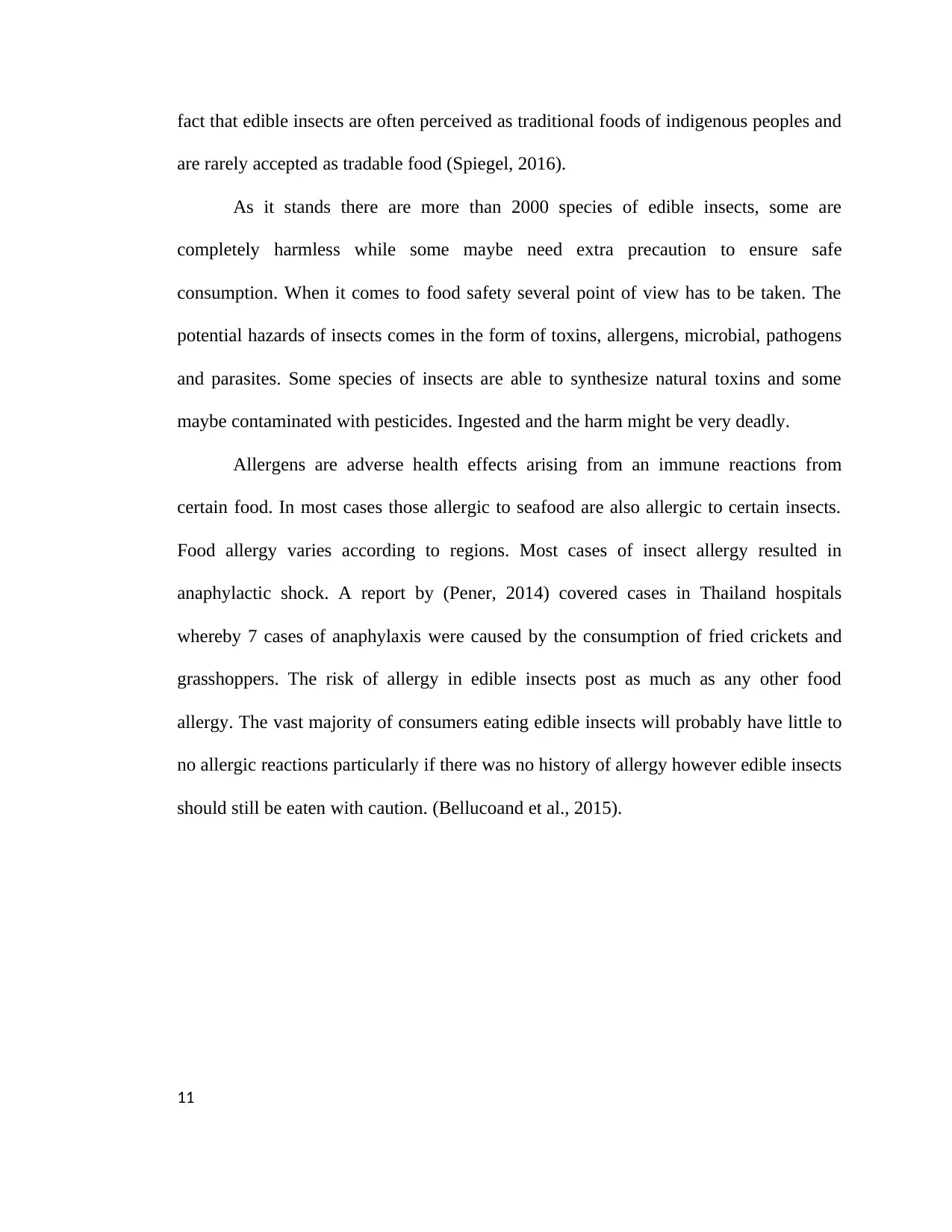
fact that edible insects are often perceived as traditional foods of indigenous peoples and
are rarely accepted as tradable food (Spiegel, 2016).
As it stands there are more than 2000 species of edible insects, some are
completely harmless while some maybe need extra precaution to ensure safe
consumption. When it comes to food safety several point of view has to be taken. The
potential hazards of insects comes in the form of toxins, allergens, microbial, pathogens
and parasites. Some species of insects are able to synthesize natural toxins and some
maybe contaminated with pesticides. Ingested and the harm might be very deadly.
Allergens are adverse health effects arising from an immune reactions from
certain food. In most cases those allergic to seafood are also allergic to certain insects.
Food allergy varies according to regions. Most cases of insect allergy resulted in
anaphylactic shock. A report by (Pener, 2014) covered cases in Thailand hospitals
whereby 7 cases of anaphylaxis were caused by the consumption of fried crickets and
grasshoppers. The risk of allergy in edible insects post as much as any other food
allergy. The vast majority of consumers eating edible insects will probably have little to
no allergic reactions particularly if there was no history of allergy however edible insects
should still be eaten with caution. (Bellucoand et al., 2015).
11
are rarely accepted as tradable food (Spiegel, 2016).
As it stands there are more than 2000 species of edible insects, some are
completely harmless while some maybe need extra precaution to ensure safe
consumption. When it comes to food safety several point of view has to be taken. The
potential hazards of insects comes in the form of toxins, allergens, microbial, pathogens
and parasites. Some species of insects are able to synthesize natural toxins and some
maybe contaminated with pesticides. Ingested and the harm might be very deadly.
Allergens are adverse health effects arising from an immune reactions from
certain food. In most cases those allergic to seafood are also allergic to certain insects.
Food allergy varies according to regions. Most cases of insect allergy resulted in
anaphylactic shock. A report by (Pener, 2014) covered cases in Thailand hospitals
whereby 7 cases of anaphylaxis were caused by the consumption of fried crickets and
grasshoppers. The risk of allergy in edible insects post as much as any other food
allergy. The vast majority of consumers eating edible insects will probably have little to
no allergic reactions particularly if there was no history of allergy however edible insects
should still be eaten with caution. (Bellucoand et al., 2015).
11
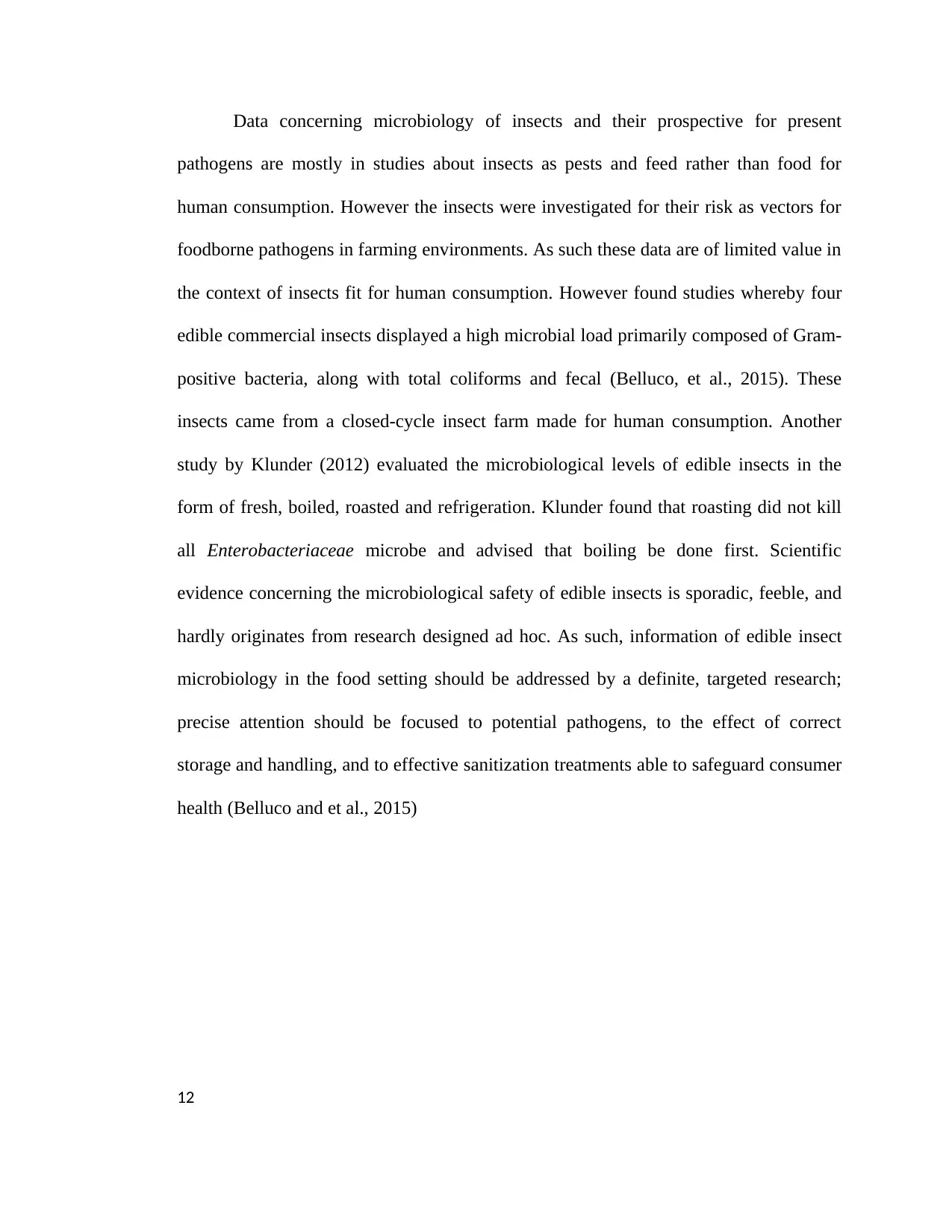
Data concerning microbiology of insects and their prospective for present
pathogens are mostly in studies about insects as pests and feed rather than food for
human consumption. However the insects were investigated for their risk as vectors for
foodborne pathogens in farming environments. As such these data are of limited value in
the context of insects fit for human consumption. However found studies whereby four
edible commercial insects displayed a high microbial load primarily composed of Gram-
positive bacteria, along with total coliforms and fecal (Belluco, et al., 2015). These
insects came from a closed-cycle insect farm made for human consumption. Another
study by Klunder (2012) evaluated the microbiological levels of edible insects in the
form of fresh, boiled, roasted and refrigeration. Klunder found that roasting did not kill
all Enterobacteriaceae microbe and advised that boiling be done first. Scientific
evidence concerning the microbiological safety of edible insects is sporadic, feeble, and
hardly originates from research designed ad hoc. As such, information of edible insect
microbiology in the food setting should be addressed by a definite, targeted research;
precise attention should be focused to potential pathogens, to the effect of correct
storage and handling, and to effective sanitization treatments able to safeguard consumer
health (Belluco and et al., 2015)
12
pathogens are mostly in studies about insects as pests and feed rather than food for
human consumption. However the insects were investigated for their risk as vectors for
foodborne pathogens in farming environments. As such these data are of limited value in
the context of insects fit for human consumption. However found studies whereby four
edible commercial insects displayed a high microbial load primarily composed of Gram-
positive bacteria, along with total coliforms and fecal (Belluco, et al., 2015). These
insects came from a closed-cycle insect farm made for human consumption. Another
study by Klunder (2012) evaluated the microbiological levels of edible insects in the
form of fresh, boiled, roasted and refrigeration. Klunder found that roasting did not kill
all Enterobacteriaceae microbe and advised that boiling be done first. Scientific
evidence concerning the microbiological safety of edible insects is sporadic, feeble, and
hardly originates from research designed ad hoc. As such, information of edible insect
microbiology in the food setting should be addressed by a definite, targeted research;
precise attention should be focused to potential pathogens, to the effect of correct
storage and handling, and to effective sanitization treatments able to safeguard consumer
health (Belluco and et al., 2015)
12
⊘ This is a preview!⊘
Do you want full access?
Subscribe today to unlock all pages.

Trusted by 1+ million students worldwide
1 out of 72
Related Documents
Your All-in-One AI-Powered Toolkit for Academic Success.
+13062052269
info@desklib.com
Available 24*7 on WhatsApp / Email
![[object Object]](/_next/static/media/star-bottom.7253800d.svg)
Unlock your academic potential
Copyright © 2020–2025 A2Z Services. All Rights Reserved. Developed and managed by ZUCOL.





